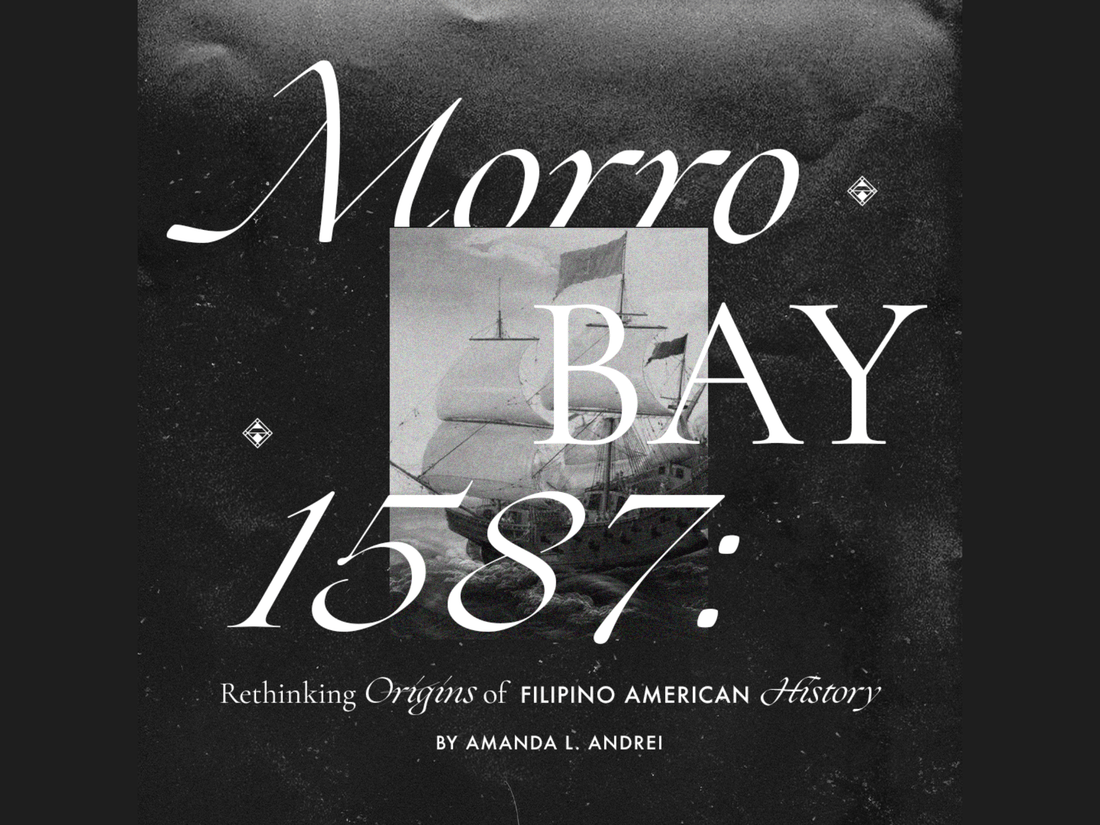Morro Bay, 1587: Rethinking Origins of Filipino American History
By Amanda L. Andrei, Guest Writer for VINTA Gallery
For a month, two oak trees had been on fire. Two plumes of smoke billowed into the sky, drawing the attention of the strangers. As the oaks burned, several foreign scouts circled the area, looking for signs of other people. They noted the flowers, the terrain, and an abandoned settlement before leaving.
The oaks burned.
Sight of these smoldering trees was part of the record of Pedro de Unamuno (also referred to as Unamunu or Unamuño), a Spanish soldier and explorer who brought his expedition from Macau to modern day Central California on October 18, 1587. (1) Sailing on his galleon Nuestra Señora de la Esperanza (Our Lady of Hope), he was one of many sailors whose goal was to find safe ports between Asia and Acapulco, Mexico and claim land along the way for the King of Spain. Joining the expedition was a Spanish Jesuit priest, a Portuguese Franciscan priest, several soldiers, and “Yndios Luçones,” also known as “Luzon Indians,” whom today we might call “Filipinos.”
It's worth noting that the term “Filipino” was used in that period to refer to Spaniards born in the Philippine colonies, and only around the 1890s did “wealthy, Spanish-educated, and highly cosmopolitan mestizos” start to use the term “Filipino.” (2) Spanish colonial authorities divided up people into various categories such as “indio/india” (natives), “chinos” (Chinese), and “mestizo/mestiza” (“mixed”) — which could be further divided into different racial backgrounds), and bestowed various economic, social, and political privileges on people according to their racial grouping.
But back in 1587, these ancestors were called “Yndios Luçones” — without leaving us a clear understanding of where exactly in Luzon they came from, or of whether the name of this northern region of the Philippines was simply used for the entire archipelago. At times in Unamuno’s record, they are referred to as “Yndios de los nuestros” — “our Indians,” part of the European expedition. This phrasing distinguished them from the other “Yndios” — that is, the indigenous tribes in that part of California. The Yndios Luçones were the scouts, “first to investigate the unchartered, and first to encounter danger.” (3)
Did they think of danger, when they saw those flaming trees? Did they think it an evil omen? Maybe it reminded them of ceremonies in the past — or maybe it sent chills through their bones, thinking of the future.
And what else of their encounters during the two days they were on the land? Initially, the Yndios Luçones came across a small group of natives — including two women with children on their backs — who fled when they saw the scouts. (These natives may have belonged to a Salinan or Northern Chumash community, indigenous groups along the California coast.) After the natives fled, the Yndios Luçones and the European soldiers climbed hills and witnessed rivers, finding no other settlements or inhabitants. They watched Unamuno and a Spanish magistrate possess the land for King Philip II: running up a cross, cutting branches of native trees, and performing “customary ceremonies” in the name of this faraway ruler. (4)
Afterwards, they camped and slept under three big oak trees. Little did they know that as they were scoping out the natives, the natives were also scoping out their intruders.
The day that Unamuno travelled inland, several members of his crew decided to disembark from the galleon. A group of Yndios Luçones and a barber left the ship and camped on the beach, collecting firewood and gathering water. A group of natives approached the camp from a hill, attempting to communicate, but then also taking some clothes and containers from the expedition. As they did so, they continued watching the men on the galleon, who then fired upon the raiding party, causing them to retreat.
It seems unsurprising, then, that as Unamuno’s exploration contingent returned to their ship the next day, they fell under attack from the natives, armed with javelins and arrows. The explorers shot at the natives with their guns. Several Europeans were wounded by the natives. One soldier and one Yndio Luçon were killed, speared by javelins. Several natives were also wounded and killed during the skirmish.
Understandably so, Unamuno decided not to explore the land any further. They set sail directly for Acapulco, landing there a month later.
* * *
Currently, there is a plaque at Coleman Park in Morro Bay, a coastal city in Central California. Dedicated on October 21, 1995 by the Filipino American National Historical Society, its summary of the encounter includes the information, “A landing party was sent to shore which included Luzon Indios, marking the first landing of Filipinos in the continental United States.” (5)
And yet, historians differ if this port landing was actually in Morro Bay or Monterey Bay. Most likely it was in Morro Bay, based on one historian’s extensive research and multiple trips to the location, yet it still remains an uncertainty in the historical record. (6) Furthermore, this uncertainty over location reflects other ambiguities in the crafting of this event as the genesis of Filipino American history (as seen with the multiple names of the Philippine inhabitants), as well as layers of transcription and translation with copying and interpreting the original sixteenth century Spanish writing into English.

The historicizing of this event also captures anxieties over Filipino American senses of belonging and desires for rootedness and authenticity. Somehow, being “first” among other foreign groups is supposed to be a source of pride and originality. Philippine scholar and writer E. San Juan Jr. critiques the dilemma:
“Why this obsessive quest for who came first? Is precedence a claim to authenticity and autochthonous originality? What if we came last, not “fresh off the boats,” clinging to the anchors or even floating on driftwood? Does this entitle us less to “citizenship” or the right to be here? Who owns the land, this continent anyway—the “natives” before the cartographer Amerigo Vespucci was recast as the name-giver to a whole continent?
[…]
We may therefore be truly naifs if we ignore the advent of United States power in Manila Bay (not Morro Bay) in 1898. This is the inaugural event that started the process of deracination, the primordial event that unfolded in the phenomena of pensionados and the recruits of the Hawaiian Sugar Plantation up to the “brain drain” of the seventies, the political opportunists who sought asylum during the Marcos dictatorship, and the present influx of this branch of the Filipino diaspora. To shift to the romance of the Spanish Galleons is to repress this birth of the Filipino in the womb of the imperial body, a birth which […] implies liberation.” (7)
In other words, consider not fixating on Morro Bay as the proud, pioneering origin story of Filipino American history. Rather, start in a historical event that was more shameful and traumatic: the violent conflict between American and Spanish imperial forces in the Philippines and the subsuming of the archipelago from an old empire into a new one.
And consider all the illusions of empire wrapped up in the collective Filipino/American memory:
The Philippine student funded by the government to study abroad (usually in America, the new colonial master’s house).
Filipino labor imported to Hawaii before, after, and during the world wars in order to cut sugar and pick pineapples on plantations.
Scholars and intellectuals fleeing martial law (whom San Juan Jr. also dubs “opportunists” — a whole other dilemma to address in the diasporic Philippine community, about who stayed and who left during the 1970s and 80s).
The current state of the Filipino diaspora with families separated and working overseas, as well as generations of diasporic Filipino/a/x who attempt to connect to the Philippines but find themselves at a loss due to linguistic and cultural barriers.
Another cross run into the ground. More branches cut from their trees. A land on fire.

What would happen if we acknowledge “this birth of the Filipino in the womb of the imperial body” — the violence of American conflict in the Philippines struggling to free itself of Spanish empire — as the beginnings of Filipino American history and contemporary Filipino history?
What happens when we bring our shame into the light?
When we thoughtfully critique and reimagine historical events — ones that have been romanticized by our own communities and desires for belonging — can we move towards liberation?
When we acknowledge multiple ambiguities and make efforts to revisit historical texts and sites, such as the translations of the voyage and the plaque on Morro Bay, can we move towards light?
And when we find ways to heal land “claimed” by foreign authorities for purposes of expansion and exploitation, can we move towards awareness and understanding?
Like those oak trees centuries ago, our community burns and smolders, transforming into something new. We acknowledge the messy multitudes of ancestors — conquered and unconquered and conquerors — and the various contradictions they hold. The contradictions we hold, as living ancestors.
As we blaze, sending out heat and light, how do we appear before those on earth? What smoke signals are you sending to the heavens?
We’ll be posting more about Filipino American History Month here and on Instagram.
--- ---
ENDNOTES
1 Borah, Eloisa Gomez. "Filipinos in Unamuno's California expedition of 1587." Amerasia Journal 21.3 (1995): 175-184.
2 Hedman, Eva-Lotta, and John Sidel. Philippine politics and society in the twentieth century: colonial legacies, post-colonial trajectories. Routledge, 2005.
3 Borah, ibid.
4 Mercene, Floro L. Manila men in the new world: Filipino migration to Mexico and the Americas from the sixteenth century. UP Press, 2007.
5 “San Luis Obispo County Points of Interest: Filipino Landing.” NoeHill Travels in California, https://noehill.com/sanluisobispo/poi_filipino_landing.asp
6 Wagner, Henry R. "Spanish Voyages to the Northwest Coast in the Sixteenth Century: Introduction and Chapter" Alvarado and Mendoza, Partners" California Historical Society Quarterly 6.4 (1927): 293-331.
7 Juan Jr, E. San. "Fragments from a Filipino exile's journal." Amerasia Journal 23.2 (1997): 1-26.
Amanda L. Andrei is a playwright, literary translator, theater reviewer, and community archivist based in Los Angeles. She writes epic, irreverent plays that center the concealed, wounded places of history from the perspectives of diasporic Filipina women. To learn more about her upcoming events and offerings, join her newsletter.

